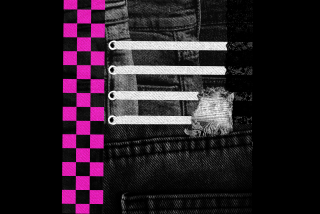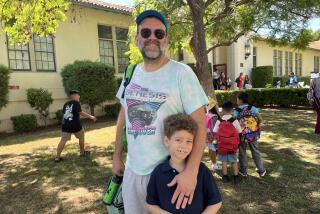For These Students, U.S. History Is a Ball
President Abraham Lincoln sits in a rocking chair at one end of the room, the war recently won and his assassination less than a week away.
Tonight is one for celebration. “The Battle Hymn of the Republic” plays, and from one door comes a line of more than 100 ladies in formal gowns and hoopskirts, dressed for the occasion. Through another door walk returning soldiers: blue coats with a trickle of ragged grays. The young men bow, the young women curtsy, and arm in arm, the couples--there are more than 200 dancers--pass under an arch to pay their respects to the 16th president.
This might be early April 1865. But a few odd details belie the effect. The women in dresses are, for the most part, taller than the men in uniform. On closer inspection, a few sideburns seem to have been drawn on in magic marker. Braces are visible when some revelers smile.
And under trouser cuffs and skirts, all the soldiers and belles are wearing tennis shoes, a requirement not of any Northern general but of an athletic director wary of what soldiers’ boots might do the floor of the boys gymnasium.
This is El Segundo in 2002.
The Middle School Blue and Gray Ball is exactly the kind of event that many educators predicted would fall by the wayside as California school districts embarked on a new era of state curriculum requirements, federal mandates and standardized testing. With so many new duties, the argument went, schools would scale back events and cancel fun.
But in practice, some school districts are adding and strengthening traditions. Superintendents and principals say that with all the state and federal government standards, local communities are celebrating distinctive traditions more fiercely than ever. That is the case at the 2,900-student El Segundo district, located just south of Los Angeles International Airport.
Few events are more elaborate than El Segundo’s Civil War-era ball, which is part junior high dance, part history lecture, part reenactment. In addition to the more than 200 dancers from El Segundo Middle School, an estimated 350 spectators attended last week’s performance, filling the bleachers.
“It’s been quite an upgrade this year. The crowds keep getting larger,” said Dan Webb, principal of El Segundo Middle School, who dances the waltz during the ball. “It’s so easy to make excuses that you can’t do these things. But you do all that routine stuff--tardiness and professional development and testing--so that at the end of the year, you can do something like this.”
The Blue and Gray Ball’s chief appeal is that it’s an academic exercise. Started four years ago, it grew out of the state’s content standards, which outline an extensive unit on the Civil War in the eighth grade. In El Segundo, the annual ball marks the end of the unit for all eighth-graders.
After its first year, the ball’s organizer left for another school, and it was unclear whether the idea would be renewed. Robin Teitelbaum, a new teacher, agreed to take it on. “There was really no way to say no,” said Teitelbaum, 26, whose mother also teaches in the El Segundo district. “It was obviously something the community would really support--we see it as a reunification of community type of thing--with Union soldiers and Confederate soldiers, coming together at the end of the war to have a good time.”
A parents committee helps. Decorating the gym is an elaborate project, with bunting and flags from each state in the Union and Confederacy hung on the walls, as well as period artwork. The local PTA provides $1,000 in financial support--$600 of which goes to hire a troupe of Civil War reenactors from Santa Barbara, $200 for decorations, and the rest for various odds and ends.
The eighth-graders begin practicing as much as three months ahead. Students are responsible for their own uniforms and dresses. Some rent from clothing and costume stores on a list provided by Teitelbaum. Others make their own; one girl fashioned a hoopskirt using a hula hoop and a hand-me-down quinceanera dress.
The ball has a handful of critics. One parent this year questioned the use of Confederate flags, which are paired with the Stars and Stripes on signs made for the ball.
“We’re not trying to glorify slavery,” Teitelbaum said. “But we don’t want to do a disservice to our students by sugar-coating history.”
Some of the eighth-grade boys grumble about the time and effort it takes for a dress-up event.
The ball is not mandatory, but peer pressure and the promise of a few extra points in history class bring in more than 200 of the approximately 215 eighth-graders.
“Most of the guys could care less,” said eighth-grader Chris Doukakis, 13, who made a soldier’s uniform with a jacket borrowed from his uncle, a hat his brother bought at Disneyland, and a $6 plastic sword. “It’s tradition, and the girls are very into this.”
“It’s a great way,” said a camera-toting mother, Donna Tucker, as she filmed daughter Danielle in a blue dress, “to learn history hands-on.”
It is also a spectacle. After their bows to Lincoln, the revelers begin to dance. They start with the Virginia Reel, filling the entire gym floor as they sway and twirl. After a short break for pie and lemonade, the entire room dances a delicate waltz. Twenty or so dancers--who put in extra practice--perform an elaborate polka.
The adult reenactors also get into the action. One, impersonating a Confederate soldier from North Carolina, plays the banjo. Lincoln, played by Don Ancell, a suitably tall and bearded retired Navy electronics technician from Oxnard, moves with characteristic awkwardness as he talks about the need for reconciliation, tells stories about his early failures in business, and recites the Gettysburg Address. He breaks character only in his conclusion, advising the young dancers to “Stay away from that TV set and work hard, man.”
Even skeptics--most of them male--were won over.
“I thought it’d be a very teacher sort of night,” said Marcus Caimi, 14, who rented the costume of a riverboat gambler for $43. “But I had a blast.”
In the stands, Milagro Archila said she felt great emotions watching her daughter Vivian dance in a dress they struggled to find. Archila, a native of El Salvador who moved here in 1976, says she never had the chance to study the American Civil War. But as Lincoln talked about the 620,000 dead Americans, her thoughts turned to the civil war in the country of her birth.
She said she often talks with her children about that war, which killed some of her friends and forced others to leave.
“It’s important to understand what happens in civil war, that people and neighbors die,” Archila said. “Fortunately, tonight is not a real civil war. War is terrible, and this is happy.”
More to Read
Sign up for Essential California
The most important California stories and recommendations in your inbox every morning.
You may occasionally receive promotional content from the Los Angeles Times.










